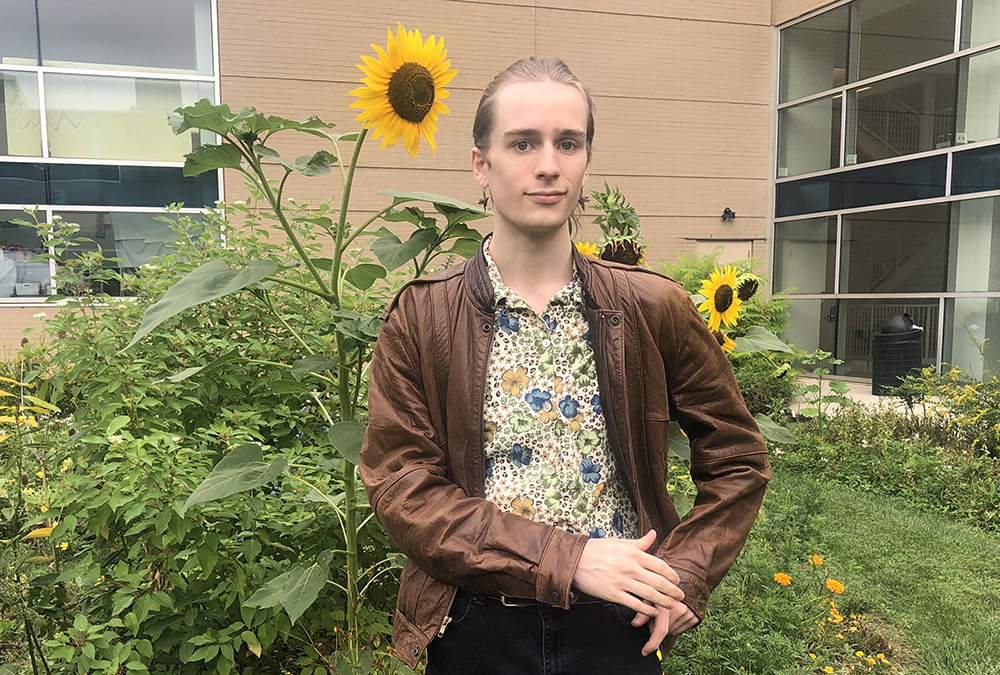Coloring book facilitates climate justice activism in Philadelphia neighborhoods
October 15, 2021
In spring 2021, Visual Studies major Holly Hazell (TYL ‘22) was looking for a meaningful way to plug into community arts work and found the perfect opportunity with a project that highlights how extreme heat disproportionately affects low-income neighborhoods in Philadelphia.
Through an independent study in the Community Arts Practices program, Hazell worked with a local artists’ group, Amber Art and Design, and the Trust for Public Land’s Heat Response Project to create Seedlings: Fighting the Danger of Heat, a 32-page coloring book with a band of superhero plants discussing the perils of climate change. They were joined by alum Kenza Bousseloub (TYL ’21), who led the writing of the text.

Visual Studies major Holly Hazell (TYL ‘22) worked with a local artists’ group, Amber Art and Design, and the Trust for Public Land’s Heat Response Project to create Seedlings.
Hazell said the group hit upon the idea of a coloring book because it would be easily distributed in communities to engage residents in the issue of urban heat. Hazell illustrated all the pages to convey core, scientific concepts like “heat islands” as well as issue a call to action to protect the environment. In drawing the illustrations, Hazell used a comic-book super hero aesthetic to appeal to children and adults alike.
The project “was a great way to apply my skills to reach people and apply art in a way where you can really see the connections that art can make,” Hazell said, who worked for the duration of the spring semester on the project.
“Many art schools focus on the classical trajectory of arts – art exists in a gallery. But (this project) was a different take on how art can operate. I was able to be involved in what’s affecting people in the neighborhoods around where I’m going to school, little tree cover, asphalt and concrete that soaks up sun, people not having a way to escape the heat.”
Hazell and their team hit upon the idea of a coloring book because it was “a grounded way into issues that can seem catastrophic and unapproachable, overwhelming issues,” they said. Hazell worked digitally to keep consistent line weights, using a pen and tablet for the drawings. Using the software Procreate, they incorporated the text onto each page and exported the files to PDFs to be compiled into one booklet.
The coloring book is written and designed to be educational but not too academic and visually dry as to turn people off, Hazell said, adding that they like the comic book format because the marriage of image and text make for flexible representations.

A spread from Seedlings, a 32-page coloring book with a band of superhero plants discussing the perils of climate change.
Readers will see different cultures and environments in the coloring book illustrations. Galena the Willow Tree is an elder-like figure with healing powers; Morning Glory talks about blooming in summertime but the difficulty of flourishing in extreme heat. Other superhero trees such as the oak and maple represent the ability to cool the air.
Hazell said the group was careful to share messages about actions people can take to help fight urban heat versus things they are doing wrong. Throughout the coloring book, there are calls to plant more trees and turn concrete patches into gardens and parks. The book also positions the reader as part of a team “so they won’t be taking action alone,” they said,
Hazell helped to distribute the coloring book to residents in the Fairhill section of North Philadelphia, along markers and crayons. Over the summer, the coloring book was incorporated into Philadelphia’s Parks and Recreation Department programs as well as other public events. The Philadelphia public school system has also inquired about using the coloring book in its curriculum.
Hazell said that creative expression tied to meaning “is an experience I have always valued. Now I can impart that to others. [The coloring book] provides new ways of visualizing problems and solutions and tapping into [readers’] creativity.”
As for how to measure the impact of the publication, Hazell said that question was being asked by the Heat Response team now. But for them, “I love seeing pictures of kids coloring in the book. I’d like for it to be a conversation starter between people about things that are affecting them day to day and to spread ideas around.”
TEXT: WANDA MOTLEY ODOM
On October 27, 2021, Community Arts Practices will host a pop-up event in the Tyler School of Art and Architecture's atrium to celebrate the Seedlings coloring book launch. This pop-up event will include four interactive and informational stations where students can make art, share stories, and learn about climate issues. All Temple students, faculty and staff are welcome.